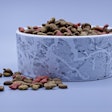The development of alternatives to fossil fuels in meeting the United States' energy needs truly is a commendable goal. Both biodiesel and ethanol have great potential in this regard, and the energy industry is rapidly expanding production of both products. However, this increased production is accompanied by the increased generation of co-products.
An oversupply of potential feed ingredients such as glycerin and distillers grains is anticipated in coming years, resulting in lower costs of these ingredients as well. To address what this may mean for the animal feed and petfood industries, the Association of American Feed Control Officials (AAFCO) held a special session entitled "Fitting Biofuel Co-products Into Feed: Symposium on Process, Definition & Utility" at its January midyear meeting in Savannah, Georgia, USA.
Glycerin
Contrary to the assumptions of some, biodiesel is more than simply filling your gas tank with spent French fry oil. Rather, it is produced by breaking up the triglycerides in fats and oils with an alcohol such as methanol. This reaction results in the formation of fatty acid methyl esters, which becomes the biodiesel fuel. The co-product of this reaction is glycerol (or glycerin). For every triglyceride molecule, three molecules of fatty acid esters and one molecule of glycerin is produced.
That glycerin has to go somewhere. Potential destinations include use as fuel, in de-icers and dust control agents, as a substrate for fermentation and for synthesis of chemical compounds such as propylene glycol. However, it also has significant potential for use in feed.
Glycerin is presently AAFCO-defined and codified as generally recognized as safe (GRAS) for use in animal feed (including petfood) in Food and Drug Administration (FDA) regulations. As reported by some of the presenters at the symposium, it has good energy value (equivalent to corn, better than molasses), is water soluble, has a pleasant odor and sweet taste. Its inclusion in feeds can also have preservative properties while helping the product retain moisture. Recommended inclusion rates in feed range from 5-20% depending on intended species. Use in petfoods specifically isn't mentioned, though.
Distillers grains
When fermented, one bushel of corn (54 pounds) yields about 2.6 gallons of ethanol fuel. However, a sizable portion of the corn is not fermentable. About one-third (17 pounds) of that same bushel ends up as "distillers dried grains with solubles" (DDGS). Again, that material has to go somewhere.
Distillers grains are also AAFCO-defined and have long been used as a good source of energy and protein in animal feed. In fact, presenters reported that this co-product is better than that derived from fermentation to produce potable alcohol and exceeds existing National Research Council (NRC) data for nutritive value. For example, the estimated metabolizable energy value of DDGS from fuel ethanol production for swine is 3828 kcal/kg, while NRC reports only 3032 kcal/kg. In addition to DDGS, there are other potential co-products that may be suitable for use in feed. For example, corn germ removed from the corn "up front" (prior to fermentation) is higher in protein and amino acids while lower in fat.
Regulatory concerns
While data to demonstrate the potential use of these co-products in feed appear promising, FDA still has some significant issues with feed ingredients derived from fuel production versus traditional sources. For example, while glycerin is codified as GRAS, there is still question as to whether glycerin from this source would meet the Food Chemicals Codex or United States Pharmacopeia standards. FDA is also concerned about potential residues in glycerin from production of biodiesel, especially methanol residues. While there is precedent for establishing limits on methanol residues for feed ingredients in the FDA regulations, the concentrations of methanol in glycerin most often would be higher than previously allowed.
With respect to distillers grains, FDA is concerned about the types and amounts of antibiotics used in the fermentation process for fuel ethanol production and the potential for residues to form toxic metabolites or create antibiotic resistant strains of microorganisms. Another potential issue is the fact that any mycotoxins that may be in the corn become concentrated in the DDGS portion. FDA is also concerned about the use of "next generation" grains, yeasts and enzymes in the production of fuel ethanol that might not be acceptable for use in feed and the potential effects of processing aids like defoamers.
Future in petfoods?
As I understand it, industry is responding to FDA concerns with submission of safety data. Assuming the regulatory issues can be successfully addressed, what does the anticipated market glut of glycerin and distillers grains mean for the petfood industry? Glycerin is often used in soft-moist petfoods as a humectant. Its popularity for this purpose increased when regulations prohibiting use of propylene glycol in cat food were enacted in the mid-1990s. While soft-moist foods are not as popular on the market as they once were, perhaps a readily available, less-expensive source of glycerin will prompt new growth in this category.
Distillers grains have never been extremely popular for use in petfoods, but there's no compelling reason why they can't be used for that purpose. Perhaps the unappealing character of the ingredient name has hindered use. Regardless, maybe the economic, plentiful source that's predicted to be available in the near future as a result of increased ethanol production will spark new interest in this ingredient.
Copies of the slides used in the symposium presentations were not available on the AAFCO website ( www.aafco.org ) at the time of this writing. For those interested, they may be posted by the time this appears in print.















